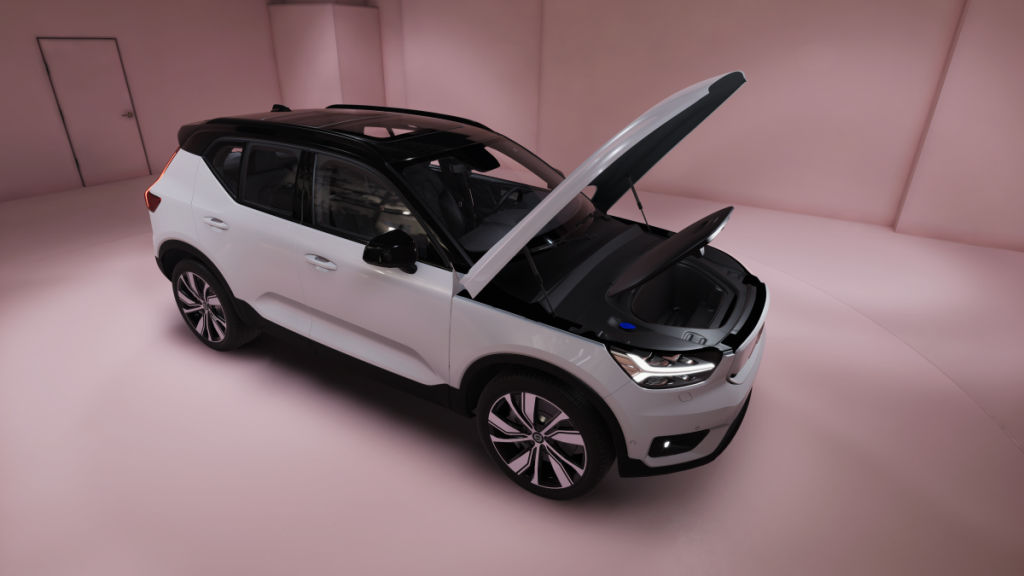Ed Martin offers a deep dive into the Innovation Portal, a design tech template collaboration between Unity and Volvo
Volvo Cars and Unity have developed a true-to-life, adjustable virtual ‘Auto Showroom’ template. This is essentially a sandbox for seeing how vehicles and other products look in a wide range of environments and lighting conditions. Efforts started with a detailed model of Volvo XC40 Recharge but the potential applications are almost limitless.
The Innovation Portal allows developers from outside Volvo to create better cars. Automotive design data is some of the most tightly restricted information in the entire industry, so why did the partners collaborate and make this model publicly available? The answer is in the shared vision that Volvo and Unity have: that by providing creators with access to professional tools and resources, both companies can support broader creativity and innovation. Just as the founders of Unity democratised game development, Volvo and Unity want to democratise the creation of real-time 3D experiences.
The template is a tool to help envision how vehicles look in a wide range of environments and lighting conditions. In a sense, this partnership reflects a longer-term trend toward increasing digitalisation in the automotive industry. The industry has used increasingly sophisticated digital tools within product development for decades, and more recently has extended digital touchpoints to include the entire consumer experience. Examples of this extended presence abound. Car configurators are becoming more interactive and lifelike, enabling consumers to experience vehicles from the comfort of their homes. In-vehicle infotainment systems are incorporating more advanced interaction and visualisation features such as mixed reality and light field displays, while supporting the connection of vehicles to more devices and networks. Active safety systems are delivering new levels of confidence and security for both vehicle occupants and pedestrians.
This transformation of automotive technology and consumer experiences is remarkable for the speed at which it has taken place. Capabilities that were the subject of futuristic speculation fewer than 20 years ago are now the features consumers expect, especially in premium vehicle segments. However, the way in which these features are delivered has stayed largely the same. Automakers and suppliers develop new technologies, refine features and certify compliance within their advanced research labs and development teams, and then compete on the basis of how their ideas are received by consumers.
It is impossible to predict all the ways in which people will make use of this template, and that is precisely the point
Volvo and Unity hope to enable a new model of open innovation by making the XC40 project available widely to anyone—professionals, academics, students, and hobbyists. The template includes three lighting themes and environments (Luxury, Photo Studio, and Light Installation) that represent common visualisation scenarios and provide aspiring 3D artists and visualisation specialists an opportunity to refine their understanding of lighting, materials, camera settings, post-processing, and other techniques. It also includes interactive controls so that users can stage a vehicle photoshoot and adjust lighting themes and paint colours, and control vehicle lights, doors, and cameras. Developers of interactive experiences can extend the model with animations and interfaces to experiment with new ways for people to interact with vehicles.
Today, the highly detailed interior and exterior model is ideal for use in visualisation applications, VR, cinematic experiences and car configurators. The project isn’t stopping with this initial model, however. Later this year, Volvo plans to update the project with expanded model functionality together with several customisable 3D environments. The model will have vehicle dynamics behaviour for driving that can be used within simulators, virtual reality rigs and autonomous driving sensor training environments. Digital replicas of physical sensors will allow developers to evaluate and experiment using realistic sensor data.

These planned extensions to the project open an entirely new set of possibilities for innovation. Researchers can use the model to better understand how drivers and passengers interact with a vehicle, and how that vehicle interacts with its external environment. The opportunities are especially relevant within academia, but anyone can use the model to learn and test out new ideas, or simply to level up their skills.
The potential for this template extends well beyond individual projects. One of the most interesting prospects is that communities of innovators can use the project, each contributing their unique skills to achieve something truly novel. XR start-ups can use the project to experiment with new ideas using a professional-grade model. Challenge projects can use it for teams to compete and learn. The possibilities are exciting to consider.
It is impossible to predict all the ways in which people will make use of this template, and that is precisely the point. Sometimes a fresh perspective is invaluable to spur innovation.
Ed Martin is Director, Verticals Product Management, at Unity Technologies
